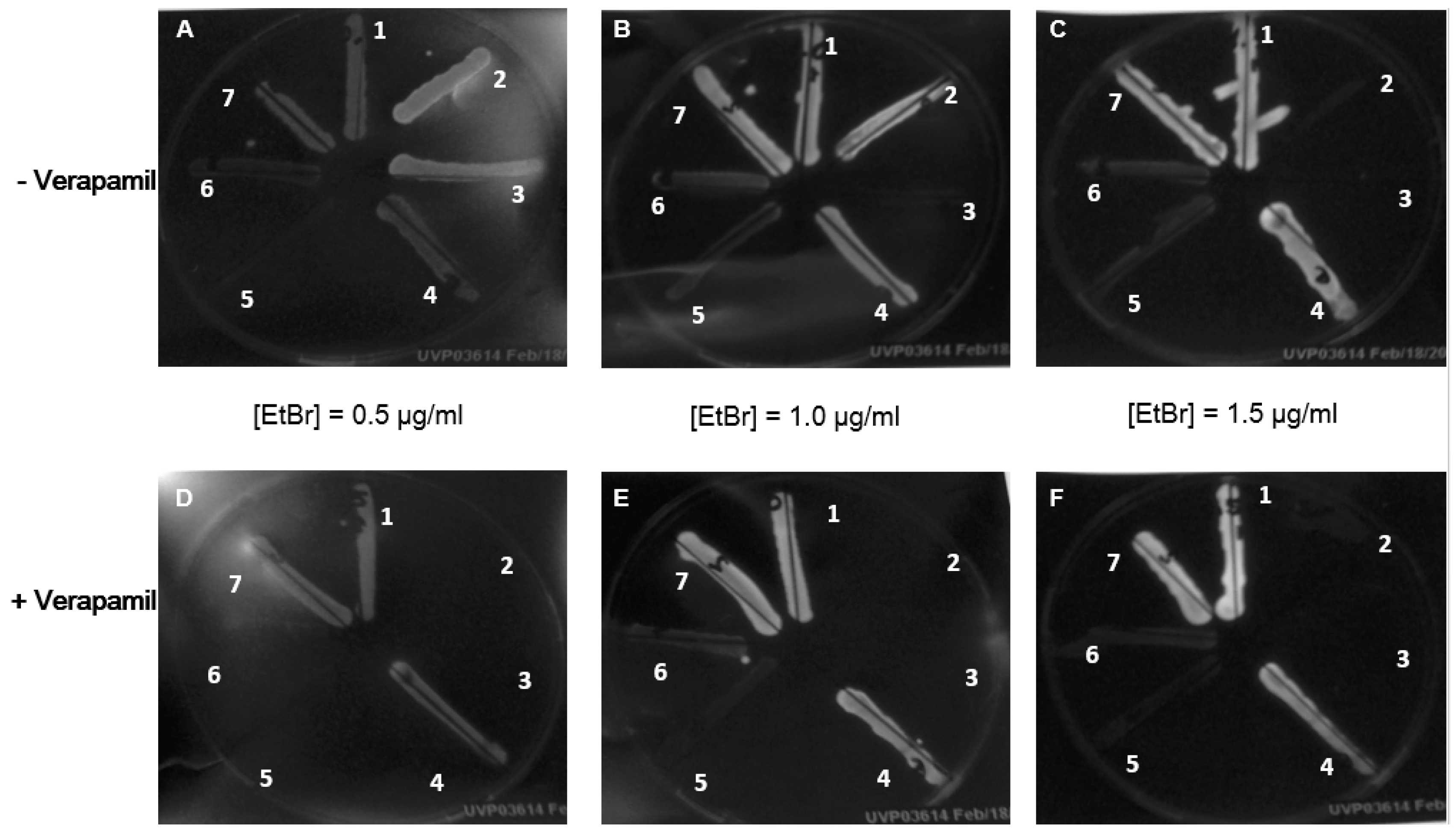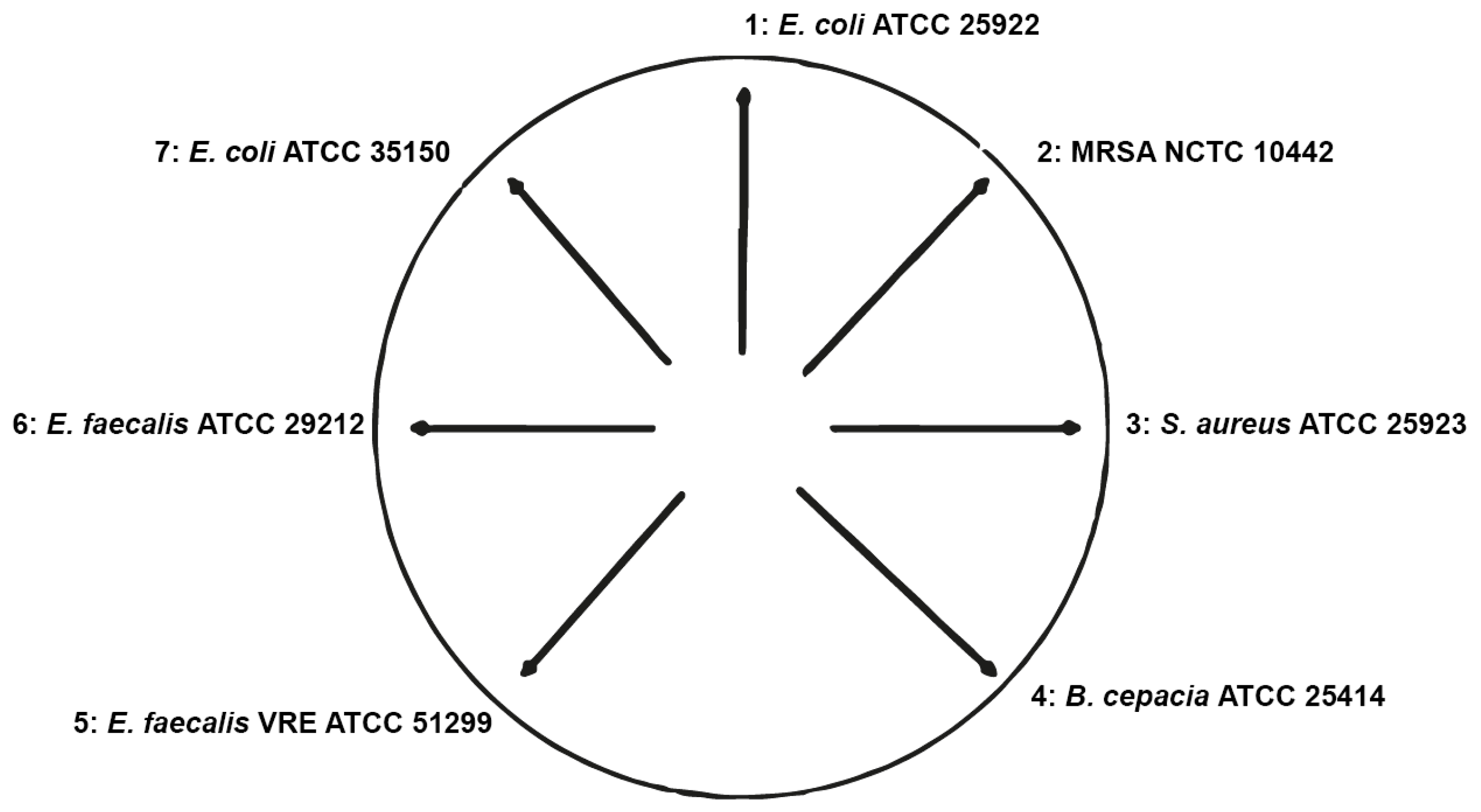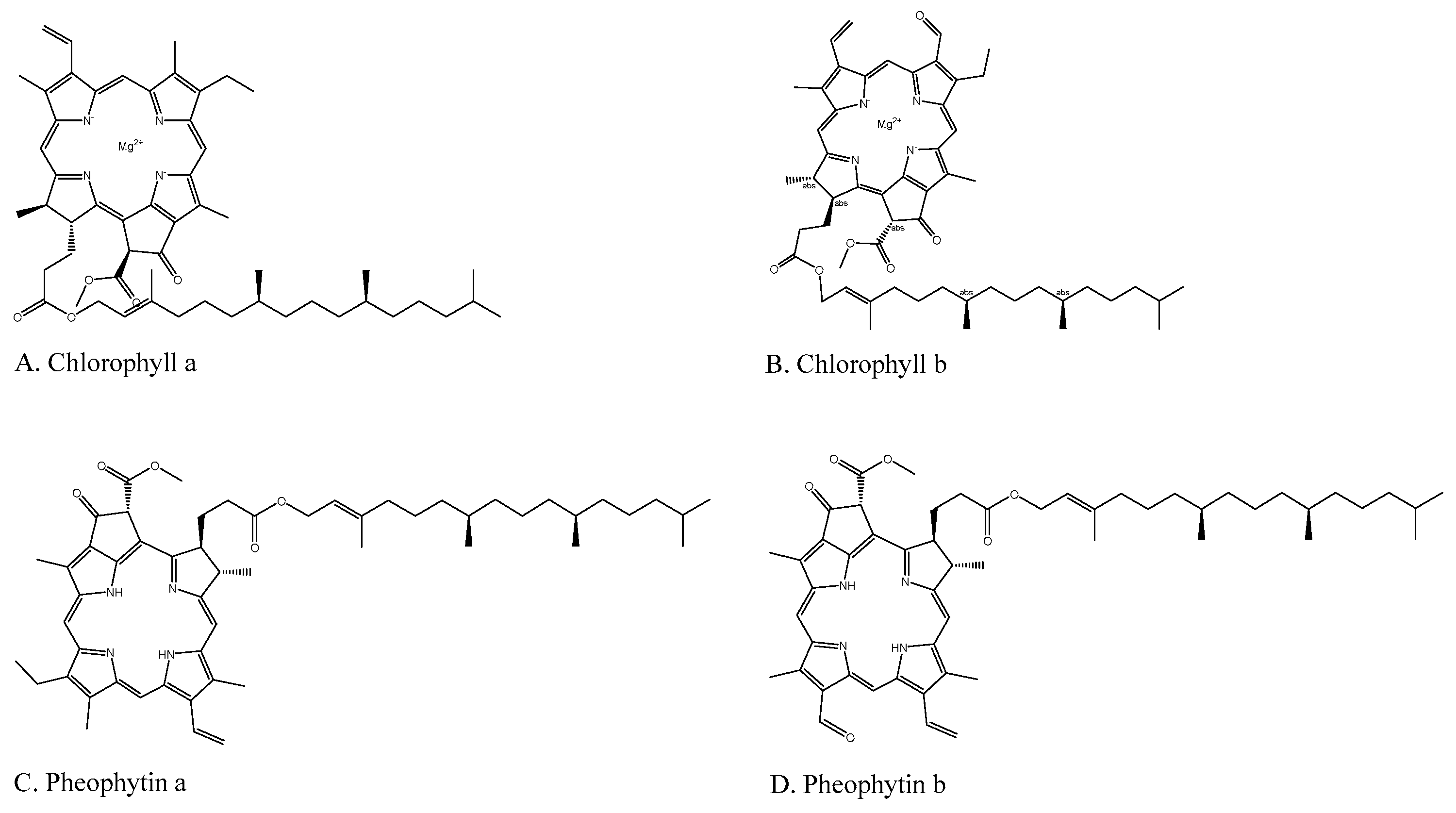Chlorophyll and Chlorophyll Derivatives Interfere with Multi-Drug Resistant Cancer Cells and Bacteria
Abstract
1. Introduction
2. Results
2.1. Cytotoxicity of Chlorophyll and Pheophytin in Human Cancer Cells
2.2. MDR Reversal Assay in CEM/ADR 5000
2.3. Selection of Bacteria for Antimicrobial Susceptibility Testing
2.4. Determination of Minimum Inhibitory Concentrations of the Single Substances
2.5. Synergism Test Using MRSA
3. Discussion
4. Materials and Methods
4.1. Chemicals and Materials
4.2. Cell Culture
4.3. Cytotoxicity Assay
4.4. MDR Reversal Assay
4.5. Statistical Analysis
4.6. Selection of Bacteria to Investigate Effects on Efflux Pump Activity
4.7. Antimicrobial Activity: Broth Microdilution of Single Agents
4.8. Synergism Between Chlorophyll and Ethidium Bromide Under Light and Dark Conditions
5. Conclusion
Author Contributions
Funding
Conflicts of Interest
References
- Gottesman, M.M.; Ling, V. The molecular basis of multidrug resistance in cancer: The early years of P-glycoprotein research. FEBS Lett. 2006, 580, 998–1009. [Google Scholar] [CrossRef] [PubMed]
- Gottesman, M.M. Mechanisms of cancer drug resistance. Annu. Rev. Med. 2002, 53, 615–627. [Google Scholar] [CrossRef] [PubMed]
- Kumar, A.; Schweizer, H.P. Bacterial resistance to antibiotics: Active efflux and reduced uptake. Adv. Drug Deliv. Rev. 2005, 57, 1486–1513. [Google Scholar] [CrossRef] [PubMed]
- Amaral, L.; Engi, H.; Viveiros, M.; Molnar, J. Comparison of multidrug resistant efflux pumps of cancer and bacterial cells with respect to the same inhibitory agents. In Vivo 2007, 21, 237–244. [Google Scholar] [PubMed]
- Li, X.Z.; Nikaido, H. Efflux-mediated drug resistance in bacteria. Drugs 2004, 64, 159–204. [Google Scholar] [CrossRef]
- Li, X.Z.; Nikaido, H. Efflux-mediated drug resistance in bacteria: An update. Drugs 2009, 69, 1555–1623. [Google Scholar] [CrossRef]
- Martins, M.; Santos, B.; Martins, A.; Viveiros, M.; Couto, I.; Cruz, A. An instrument—Free method for the demonstration of efflux pump activity of bacteria. In Vivo 2006, 20, 657–664. [Google Scholar]
- Lee, Y.S.; Han, S.H.; Lee, S.H.; Kim, Y.G.; Park, C.B.; Kang, O.H.; Keum, J.H.; Kim, S.B.; Mun, S.H.; Shin, D.W.; et al. Synergistic effect of tetrandrine and ethidium bromide against methicillin-resistant Staphylococcus aureus (MRSA). J. Toxicol. Sci. 2011, 36, 645–651. [Google Scholar] [CrossRef]
- Couto, I.; Costa, S.S.; Viveiros, M.; Martins, M.; Amaral, L. Efflux-mediated response of Staphylococcus aureus exposed to ethidium bromide. J. Antimicrob. Chemother. 2008, 62, 504–513. [Google Scholar] [CrossRef]
- Tam, J.; Wang, S.; Wong, K.; Tan, W. Antimicrobial peptides from plants. Pharmaceuticals 2015, 8, 711–757. [Google Scholar] [CrossRef]
- Wink, M.; Ashour, M.L.; El-Readi, M.Z. Secondary metabolites from plants inhibiting ABC transporters and reversing resistance of cancer cells and microbes to cytotoxic and antimicrobial agents. Front. Microbiol. 2012, 130, 1–15. [Google Scholar] [CrossRef] [PubMed]
- Stavri, M.; Piddock, L.J.; Gibbons, S. Bacterial efflux pump inhibitors from natural sources. J. Antimicrob. Chemother. 2007, 59, 1247–1260. [Google Scholar] [CrossRef] [PubMed]
- Hörtensteiner, S.; Kräutler, B. Chlorophyll breakdown in higher plants. Biochim. et Biophys. Acta (BBA)-Bioenerg. 2011, 1807, 977–988. [Google Scholar] [CrossRef] [PubMed]
- Chernomorsky, S.; Segelman, A.; Poretz, R.D. Effect of dietary chlorophyll derivatives on mutagenesis and tumor cell growth. Teratog. Carcinog. Mutagen. 1999, 19, 313–322. [Google Scholar] [CrossRef]
- Boivin, D.; Lamy, S.; Lord-Dufour, S.; Jackson, J.; Beaulieu, E.; Cote, M.; Moghrabi, A.; Barrette, S.; Gingras, D.; Beliveau, R. Antiproliferative and antioxidant activities of common vegetables: A comparative study. Food Chem. 2009, 112, 374–380. [Google Scholar] [CrossRef]
- Joseph, J.A.; Shukitt-Hale, B.; Denisova, N.A.; Bielinski, D.; Martin, A.; McEwen, J.J.; Bickford, P.C. Reversals of age-related declines in neuronal signal transduction, cognitive, and motor behavioral deficits with blueberry, spinach, or strawberry dietary supplementation. J. Neurosci. 1999, 19, 8114–8121. [Google Scholar] [CrossRef]
- Cao, G.H.; Russell, R.M.; Lischner, N.; Prior, R.L. Serum antioxidant capacity is increased by consumption of strawberries, spinach, red wine or vitamin C in elderly women. J. Nutr. 1998, 128, 2383–2390. [Google Scholar] [CrossRef]
- Bergman, M.; Varshavsky, L.; Gottlieb, H.E.; Grossman, S. The antioxidant activity of aqueous spinach extract: Chemical identification of active fractions. Phytochemistry 2001, 58, 143–152. [Google Scholar] [CrossRef]
- Wang, R.; Furumoto, T.; Motoyama, K.; Okazaki, K.; Kondo, A.; Fukui, H. Possible antitumor promoters in Spinacia oleracea (spinach) and comparison of their contents among cultivars. Biosci. Biotechnol. Biochem. 2002, 66, 248–254. [Google Scholar] [CrossRef]
- Doubrava, N.S.; Dean, R.A.; Kuc, J. Induction of systemic resistance to anthracnose caused by Colletotrichum lagenarium in cucumber by oxalate and extracts from spinach and rhubarb leaves. Physiol. Mol. Plant Pathol. 1988, 33, 69–79. [Google Scholar] [CrossRef]
- de Vogel, J.; Jonker-Termont, D.S.; van Lieshout, E.M.; Katan, M.B.; van der Meer, R. Green vegetables, red meat and colon cancer: Chlorophyll prevents the cytotoxic and hyperproliferative effects of haem in rat colon. Carcinogenesis 2005, 26, 387–393. [Google Scholar] [CrossRef] [PubMed]
- Cheng, H.; Lee, K. Cytotoxic Pheophorbide-Related Compounds from Clerodendrum calamitosum and C. cyrtophyllum. J. Nat. Prod. 2001, 64, 915–919. [Google Scholar] [CrossRef] [PubMed]
- Kraatz, M.; Whitehead, T.R.; Cotta, M.A.; Berhow, M.A.; Rasmussen, M.A. Effects of chlorophyll-derived efflux pump inhibitor pheophorbide a and pyropheophorbide a on growth and macrolide antibiotic resistance of indicator and anaerobic swine manure bacteria. Int. J. Antibiot. 2014, 2014, 1–14. [Google Scholar] [CrossRef]
- Zhao, L.; Wientjes, M.G.; Au, J.L. Evaluation of combination chemotherapy: Integration of nonlinear regression, curve shift, isobologram, and combination index analyses. Clin. Cancer Res. 2004, 10, 7994–8004. [Google Scholar] [CrossRef] [PubMed]
- Rapozzi, V.; Miculan, M.; Xodo, L.E. Evidence that photoactivated pheophorbide a causes in human cancer cells a photodynamic effect involving lipid peroxidation. Cancer Biol. Ther. 2009, 8, 1318–1327. [Google Scholar] [CrossRef] [PubMed][Green Version]
- Stojiljkovic, I.; Evavold, B.D.; Kumar, V. Antimicrobial properties of porphyrins. Expert Opin. Investig. Drugs 2001, 10, 309–320. [Google Scholar] [CrossRef] [PubMed]
- Meng, S.; Xu, Z.; Hong, G.; Zhao, L.; Zhao, Z.; Guo, J.; Ji, H.; Liu, T. Synthesis, characterization and in vitro photodynamic antimicrobial activity of basic amino acid-porphyrin conjugates. Eur. J. Med. Chem. 2015, 92, 35–48. [Google Scholar] [CrossRef] [PubMed]
- Walther, J.; Brocker, M.J.; Watzlich, D.; Nimtz, M.; Rohde, M.; Jahn, D.; Moser, J. Protochlorophyllide: A new photosensitizer for the photodynamic inactivation of Gram-positive and Gram-negative bacteria. FEMS Microbiol. Lett. 2009, 290, 156–163. [Google Scholar] [CrossRef] [PubMed]
- Kreitner, M.; Wagner, K.H.; Alth, G.; Ebermann, R.; Foissy, H.; Elmadfa, I. Haematoporphyrin- and sodium chlorophyllin-induced phototoxicity towards bacteria and yeasts—A new approach for safe foods. Food Control 2001, 12, 529–533. [Google Scholar] [CrossRef]
- Lim, D.S.; Ko, S.H.; Kim, S.J.; Park, Y.J.; Park, J.H.; Lee, W.Y. Photoinactivation of vesicular stomatitis virus by a photodynamic agent, chlorophyll derivatives from silkworm excreta. J. Photochem. Photobiol. B-Biol. 2002, 67, 149–156. [Google Scholar] [CrossRef]
- Wang, E.; Wink, M. Chlorophyll enhances oxidative stress tolerance in Caenorhabditis elegans and extends its lifespan. PeerJ 2016, 4, e1879. [Google Scholar] [CrossRef] [PubMed]
- Eid, S.Y.; El-Readi, M.Z.; Wink, M. Carotenoids reverse multidrug resistance in cancer cells by interfering with ABC-transporters. Phytomedicine 2012, 19, 977–987. [Google Scholar] [CrossRef] [PubMed]
- Martins, M.; McCusker, M.P.; Viveiros, M.; Couto, I.; Fanning, S.; Pages, J.M.; Amaral, L. A simple method for assessment of mdr bacteria for over-expressed efflux pumps. Open Microbiol. J. 2013, 7, 72–82. [Google Scholar] [CrossRef] [PubMed]
- Salin, M.L. Toxic oxygen species and protective systems of the chloroplast. Physiol. Plant. 1988, 72, 681–689. [Google Scholar] [CrossRef]
Sample Availability: Samples of the compounds chlorophyll and pheophytin are available from the authors. |




| Drug | IC50 in CCRF-CEM | IC50 in CEM/ADR5000 | Relative Resistance |
|---|---|---|---|
| Doxorubicin (µM) | 0.34 ± 0.032 | 95.76 ± 8.495 | 281.65 |
| Pheophytin (µg/mL) | 69.50 ± 3.617 | 83.42 ± 10.516 | 1.2 |
| Chlorophyll (µg/mL) | 167.44 ± 15.696 | >256 | >1.5 |
| CEM/ADR5000 Cell | CCRF-CEM Cell | |||||||
|---|---|---|---|---|---|---|---|---|
| Doxorubicin | IC50 (µM of Dox) | RR | CI | Interpretation | IC50 (µM of Dox) | RR | CI | Interpretation |
| alone | 95.76 ± 8.495 | 1 | NR | not relevant | 0.34 ± 0.032 | 1 | NR | not relevant |
| +10 µg/mL Pheophytin | 30.57 ± 4.984 | 3.13 | 0.438 | synergism | 0.34 ± 0.027 | 1 | NR | not relevant |
| +10 µg/mL Chlorophyll | 35.19 ± 4.789 | 2.72 | <0.407 | synergism | 0.35 ± 0.050 | 1 | NR | not relevant |
| Drug | MIC (µg/mL) | |
|---|---|---|
| Dark | Light | |
| Chlorophyll | >2048 | 64 |
| Pheophytin | >2048 | 128 |
| Verapamil | 512 | 512 |
| EtBr | >1 | >1 |
| Ampicillin | 8 | 8 |
| Cond. | MIC Chloro | MIC EtBr | MIC Chloro + EtBr | MIC EtBr + Chloro | FIC Chloro | FIC EtBr | FICI | Int. |
|---|---|---|---|---|---|---|---|---|
| Light | 64 | 2 | 4 | 0.03 | 0.06 | 0.02 | 0.08 | SYN |
| Dark | >2048 | 2 | >2048 | 2 | 1 | 1 | 2 | IND |
© 2019 by the authors. Licensee MDPI, Basel, Switzerland. This article is an open access article distributed under the terms and conditions of the Creative Commons Attribution (CC BY) license (http://creativecommons.org/licenses/by/4.0/).
Share and Cite
Wang, E.; Braun, M.S.; Wink, M. Chlorophyll and Chlorophyll Derivatives Interfere with Multi-Drug Resistant Cancer Cells and Bacteria. Molecules 2019, 24, 2968. https://doi.org/10.3390/molecules24162968
Wang E, Braun MS, Wink M. Chlorophyll and Chlorophyll Derivatives Interfere with Multi-Drug Resistant Cancer Cells and Bacteria. Molecules. 2019; 24(16):2968. https://doi.org/10.3390/molecules24162968
Chicago/Turabian StyleWang, Erjia, Markus Santhosh Braun, and Michael Wink. 2019. "Chlorophyll and Chlorophyll Derivatives Interfere with Multi-Drug Resistant Cancer Cells and Bacteria" Molecules 24, no. 16: 2968. https://doi.org/10.3390/molecules24162968
APA StyleWang, E., Braun, M. S., & Wink, M. (2019). Chlorophyll and Chlorophyll Derivatives Interfere with Multi-Drug Resistant Cancer Cells and Bacteria. Molecules, 24(16), 2968. https://doi.org/10.3390/molecules24162968






